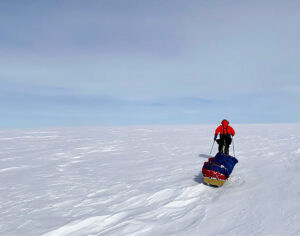Kenn Borek aircrew and their 2 patients arrived in Punta Arenas where they were transported to a medical facility that can provide a level of care that is not available at the South Pole.
National Science Foundation Press Release:
The Kenn Borek Twin Otter aircraft flying a medical-evacuation flight to bring two patients out of the National Science Foundation’s Amundsen-Scott South Pole Station arrived in Punta Arenas, Chile at approximately 9:41PM Eastern Daylight Time (EDT), June 22.
From Punta Arenas, the two patients aboard will be transported to a medical facility that can provide a level of care that is not available at Amundsen-Scott. NSF is not disclosing the location of that facility, discussing any details of the patients’ medical conditions or providing any personal details.
The plane arrived at the British Antarctic Survey’s Rothera Station at approximately 1:15 p.m. EDT June 22. It left Amundsen-Scott in the early morning hours of June 22 EDT.
NSF determined that, to mitigate risks, it would use the medical-evacuation flight to bring out a second patient. Both patients are seasonal employees through Lockheed Martin Antarctic Support Contract, the prime contract for operations and research support to NSF for the U.S. Antarctic Program.
A second Twin Otter, now at Rothera, will fly north at a later time. One plane had remained at Rothera during the Pole flight to provide search-and-rescue capability as needed.
[Editor’s note: Explorersweb/Pythom has been told that the flight from Rothera, Antarctica, to Punta Arenas takes approximately 7 hours, +/- 1 in normal conditions, October or early November.]
Background:
The Kenn Borek Air Twin Otters that left Calgary (Canada) on June14 to attempt a medical evacuation at the Geographic South Pole (90ºS). They arrived at The British Antarctic Science Base, Rothera, on June 20, where they were fitted with skis to land on snow and ice.
The aircrew took advantage of a favorable weather window to leave at approximately 8am on June 21 and arrived at the South Pole Station safely later in the day. The other plane will remain at Rothera to provide search-and-rescue capability, as needed. The South Pole plane flew back to Rothera on June 22.
It currently is mid-winter in Antarctica. Normally, flights in and out of Amundsen-Scott South Pole Station are not planned between February and October due to the extreme cold and darkness.
Kenn Borek, however, has the experience of flying two similar medical evacuation flights — one in 2001 and another in 2003.
The Twin Otter aircraft that Kenn Borek flies are able to operate in extremely low temperatures and are able to land on skis. As there is no tarmac runway at the South Pole, the aircraft must land in total darkness on compacted snow.
Because of the complexity of the operation, the evacuation will require contributions from multiple entities involved in the U.S. Antarctic Program including weather forecasts from the U.S. Navy’s Space and Naval Warfare Systems (SPAWAR) Center Atlantic; expertise from the University of Texas Medical Branch; and various contributions from ASC, NSF’s Colorado-based Antarctic logistics contractor as well as assistance from other nations.
Amundsen-Scott is one of three year-round stations NSF operates in Antarctica in its role as manager the U.S. Antarctic Program, the nation’s research program on the southernmost continent.
There are 48 people wintering at Amundsen-Scott, performing a variety of tasks related to station maintenance and science. These include overseeing long-term monitoring of the atmosphere and its constituent gases — such as methane and carbon dioxide — and scientific observations by two radio telescopes; the 10-meter South Pole Telescope and the BiCEP2 telescope, which are using the Cosmic Microwave Background to investigate the early history of the universe, including investigations of dark energy and dark matter that makes up most of the cosmos. Also included is the Ice Cube Neutrino Observatory, which is designed to observe subatomic particles, produced by some of the most violent and exotic cosmic phenomena, including black holes.
Previous/Related
South Pole evacuation plane at Rothera
Kenn Borek Twin Otter left South Pole on medical-evacuation
Kenn Borek plane in the air, and landed at the South Pole
Ken Borek Air South Pole Rescue: Updated
Kenn Borek South Pole Evacuation Flight Launched
Midwinter living on the edge: ExWeb interview with Sven Lidstrom at the South Pole
National Science Foundation News
#polar #antarctica #southpole #kennborek #medicalevacuation






